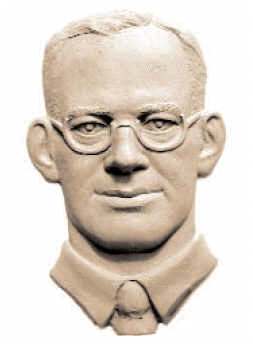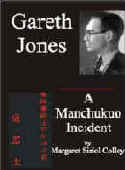Gareth Jones
[bas relief by Oleh Lesiuk]
HOME |
Stop Press |
Complete Soviet Articles & Background Information |
Précis of Gareth's
|
All Published Articles |
BOOKS
|
|
|
|
More Than Grain of Truth(2005) |
|
|
TOPICAL
'Are you Listening NYT?' U.N. Speech - Nov 2009 |
Gareth Recognised at Cambridge - Nov 2009 |
Reporter and the Genocide - Rome, March 2009 |
Order of Freedom Award -Nov 2008 |
Premiere of 'The Living' Documentary Kyiv - Nov 2008 |
Gareth Jones 'Famine' Diaries - Chicago 2008 |
Aberystwyth Memorial Plaque 2006 |
GENERAL
Scholarship Fund |
Site Map |
Links |
Legal Notices |
Sponsored Links |
Contact |
The Western Mail, 8th February 1935WALES INVADES AMERICAFrank Lloyd Wright:GENIUS WHO HAS INFLUENCED THE WORLD’S ARCHITECTUREBy GARETH JONESTALIESIN (Wisconsin); U.S.A. A rugged boulder juts out of the wall; rocks surround the fireplace where great logs are burning; a magnificent Buddha is staring down upon me; through the spacious low windows I look out upon the snow-covered Wisconsin hills and here and there I see the gleam of the birches; and at the other end of the corridor I catch a glimpse of a tall, dignified man with the flowing white hair of a bard and the calm steady movements of a dominating personality. He is my host, Frank Lloyd Wright, architect and rebel, battler against convention, insurgent against all the shams of life, the man about whom the leading literary critic of New York said: “If I were suffered to apply the word ‘genius’ to only one living American, I would say, it for Frank Lloyd Wright.” Frank Lloyd Wright! When you mention his name, note the expression on the faces of those with whom you talk in America. There is hatred, there is shock, there is disapproval, there is jealousy, there is respect, worship, adoration, but on expression you will never find, and that is indifference. “He wrestled with fire, and insanity, and a hostile public opinion with an indomitable will, and his story is a saga of experience,” was the verdict of an American writer. Fascinating PersonalityOf Frank Lloyd Wright as an architect I can say little. I can only repeat what artists say, and that is that by bursting the fetters of architecture in the ‘nineties he freed it from its unnatural, imitative character and from its imprisonment in a fortress far removed from life and that he is more responsible than any other individual for the beauty of new buildings in Europe and America. But of Frank Lloyd Wright the man I can say much. With his piercing, witty sparkling twinkle which is ever playing around his lips, with the deep sincerity of his musical voice, with the force and faith of his views, and with the charm which he radiates, he has fascinated me more than any man with the exception of Mr. Lloyd George. Hitler, ex-President Hoover, and Mr. Baldwin, although their names are known to millions more people than that of Lloyd Wright, seem ordinary and uninspiring compared with the personality of this revolutionary and poetic architect, and after the first few moments of conversation with him I agreed with J. J. P. Oud, who said that he ‘is one of the very greatest figures of this time . . . his figure towers above the surrounding world.” His Welsh DescentThe story of this rebel has its roots in the Wales of the Victorian times, when there dwelt maker of Welsh hats who, on Sunday, preached an impassioned and unpopular Unitarianism. The hatter-preacher married Mary Lloyd, and came to America, penetrating to the valley of the Wisconsin River, where they created the Lloyd-Jones family from which sprang the child who was to change the architecture of the world. And today Lloyd Wright considers himself a thorough Welshman for all the influences which have moulded him were Welsh, the chapel where his uncle Jenkin Lloyd-Jones, preached in the countryside was Welsh, and his motto which has guided him in his battles against a disapproving world is Welsh - it is, “Y Gwir yn Rrbyn y Byd.” The name of his home, Taliesin, is Welsh, and carved in wood and chiselled in stone you see the Druidic symbol /|\ in different parts of the house. From this Welsh environment arose the fighter and thinker who has so impressed me by his philosophy and by the calmness of his perfected personality, and whom I now see in grey country tweed, with a bright red jacket as he strides through the snow. Even his stride reveals a solidity and a faith which are characteristic of his work and thought and are illustrated by episodes in his troubled life. Withstood EarthquakeForty years ago he built on a high hill a windmill tower which looked so fragile that his Welsh uncles laughed at him. “It will blow down with the next squall of wind,” they cried; and whenever a storm came they would rush to ‘the window, awaiting to see the crash of the young man’s crazy structure. One by one the old folk died, but the tower still held firm against the tempest, and the hurricanes, and I have now just returned from tramping through the snow from my pilgrimage to the tower of “Romeo and Juliet,” as it is called. The Japanese many years later, hearing of Lloyd Wright’s fame as a builder of sturdy buildings, appealed to him and said. “Build us a great hotel which no earthquake, however powerful, can harm,” and he built the most famous hotel in Asia, the Imperial Hotel, Tokyo. Soon
after the great earthquake of 1923 sent the most solid of Tokyo structures
crashing to destruction, with the exception of the work of Lloyd Wright: that
remained unharmed, a monument to his genius. Architect’s Task
What lay at the foundation of his thinking about buildings? He explained to me that all architecture should be organic, by which he meant that a house must be suitable to the soil, for the climate, and for the personality of the person living in it. As he said in his “Autobiography,” the architect’s task is to “eliminate combinations of different materials in favour of mono-material so far as possible, and to use no ornament that did not come out of the nature of materials or construction, to make the whole building clearer and more expressive as a place to live in and to give the conception at the building appropriate revealing emphasis.” Lloyd Wright also sensed the great part which the machine was to play in modern architecture and he was the forerunner of the proper function of the machine in the buildings of the twentieth century. In this respect, however, his influence has been far greater in Germany and in Holland than in Great Britain, and many of the constructions in Russia are an imitation of some of Wright’s earlier schemes. “Broadacre City”Today Frank Lloyd Wright is still looking to the future. “The city of to-day is doomed,” he told me, referring to the theme of his book, “The Disappearing City.” “The day of centralisation is over. The future lies with ‘Broadacre City,’ where the individual home of the individual family group will enjoy in the country a freedom, a richness of life no city ever gave.” He is now planning this Broadacre City, where each family, freed by the advances in transport from the necessity of living huddled together in millions, can be happy on the soil. He is looking towards the future also, because the past has too much pain, too much tragedy for him. At the age of 40 he rebelled against the family and left his wife and his six children in order to gain freedom for his art, and the world condemned him violently. The very spot in which I am now staying is haunted by terrible tragedies. Home in FlamesTwice has Taliesin gone up in flames. The first time it was set ablaze by a mad negro servant, who barred and locked the doors when Lloyd Wright’s guests and closest friends were within, and seven perished within a few feet of the place where I calmly write. Later, when Taliesin was a treasure store of the richest splendours which the poet-architect had gathered in China and Japan, fire stole upon it once more and a part of the wealth of Asia and a part of the collector’s heart became within a few moments a cloud of smoke and a heap of ashes. Tragedy has followed him, but it has enriched him and made him the philosopher he is to-day, a dreamer and a builder who thinks in terms of centuries, who has drunk deep at the well of Asiatic wisdom and who has attained a “calm of mind, all passion spent.” |
Dollar, Yo-Yo. |
||||||||
|
|||||||||



